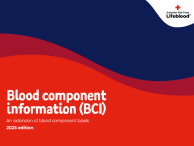Don’t have an account?
Select the donation type you’d like to make
Cryoprecipitate is prepared from plasma obtained from both whole blood and apheresis donations. Fresh frozen plasma (FFP) is slowly thawed at a temperature between 1–6 °C and the resulting cold-insoluble precipitate is removed and then refrozen. Cryoprecipitate has a shelf life of 12 months when stored at - 25 °C or below.
Cryoprecipitate contains most of the factor VIII, fibrinogen, factor XIII, von Willebrand factor and fibronectin found in FFP. It is used in major haemorrhage protocols to replace fibrinogen and in the treatment of fibrinogen deficiency or dysfibrinogenaemia when there is clinical bleeding, an invasive procedure, trauma or disseminated intravascular coagulation (DIC).
Large-dose apheresis cryoprecipitate will not be manufactured after December 2024. It is being replaced (from January 2025) with split apheresis units, with three units being produced from a single apheresis donation. This means laboratories may have a mixed inventory of large dose and split apheresis units until stocks of large dose units are used or expire.
Recommended dose
When reviewing international studies of fibrinogen replacement, ensure that the current fibrinogen content in Australian cryoprecipitate is considered when estimating equivalence. Due to differences in manufacturing process between Blood Services internationally, fibrinogen content per 'unit' (pack) and per mL can vary considerably.
Adult dosing
In Australia, the NBA Patient blood management guideline for adults with critical bleeding recommend an adult dose of fibrinogen of 3 - 4 g of fibrinogen, which may be achieved by using:
• 9 units of whole blood cryoprecipitate or
• 9 units of split apheresis cryoprecipitate or
• a combination of these as both unit types are equivalent and interchangeable.
This dose of 3 – 4 g of fibrinogen can also be achieved by using 3 units of large-dose apheresis cryoprecipitate units while stock is still available.
Paediatric dosing
The Patient blood management guidelines: Module 6 Neonatal and Paediatrics provide dosing guidance within the Critical Bleeding Protocol template for Infants and Children. The locally adapted health service Critical Bleeding Protocol and other relevant transfusion guidelines (specific to the particular patient group) should be referred to, and expert advice should be sought.
Typical unit content and specifications
The typical unit content data is derived from Lifeblood process control testing. For each parameter, the mean value (± 1 SD) and specification is shown.
Unless otherwise specified, data is for the period 1 January to 31 December 2024.
Cryoprecipitate whole blood
| Volume (mL) | 37 ± 2 (30–40) |
| Factor VIIIc (IU/unit) | 143 ± 25 (≥ 70) |
| Fibrinogen (mg/unit) | 399 ± 123 (≥ 140) |
| Von Willebrand factor (IU/unit) | 247 ± 42 (> 100) |
Cryoprecipitate apheresis
Large-dose (manufacture discontinued) | Split apheresis (From January 2025)* | |
|---|---|---|
| Volume (mL) | 60 ± 2 (54–66) | 33 ± 3 (30–40) |
| Factor VIIIc (IU/unit) | 372 ± 78 (≥ 70) | 178 ± 22 (≥ 70) |
| Fibrinogen (mg/unit) | 1173 ± 334 (≥ 140) | 395 ± 116 (≥ 140) |
| Von Willebrand factor (IU/unit) | 620 ± 102 (> 100) | 261 ± 52 (> 100) |
Note: * Split apheresis typical contents based on final validation data; one split apheresis unit is equivalent to one unit of whole blood cryoprecipitate, and these are equivalent and can be used interchangeably.
Availability
Cryoprecipitate is available in all ABO groups. Matching for RhD group is not required.
Modifications
There are no modifications available for cryoprecipitate.
Updated September 2025


